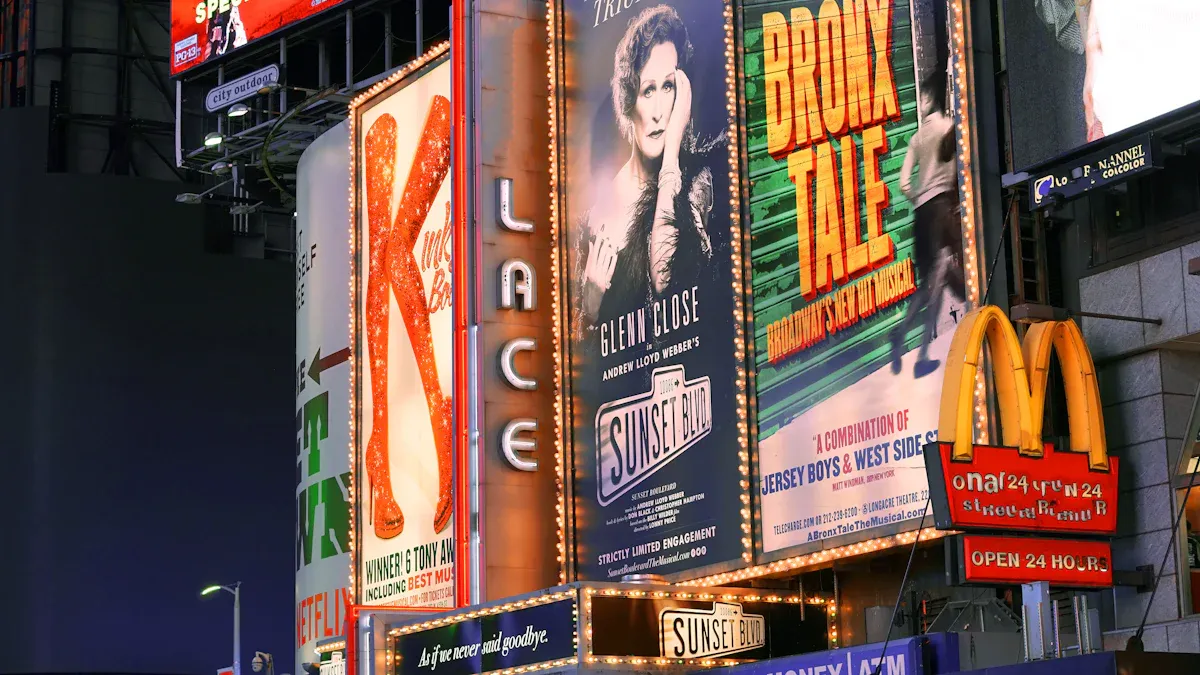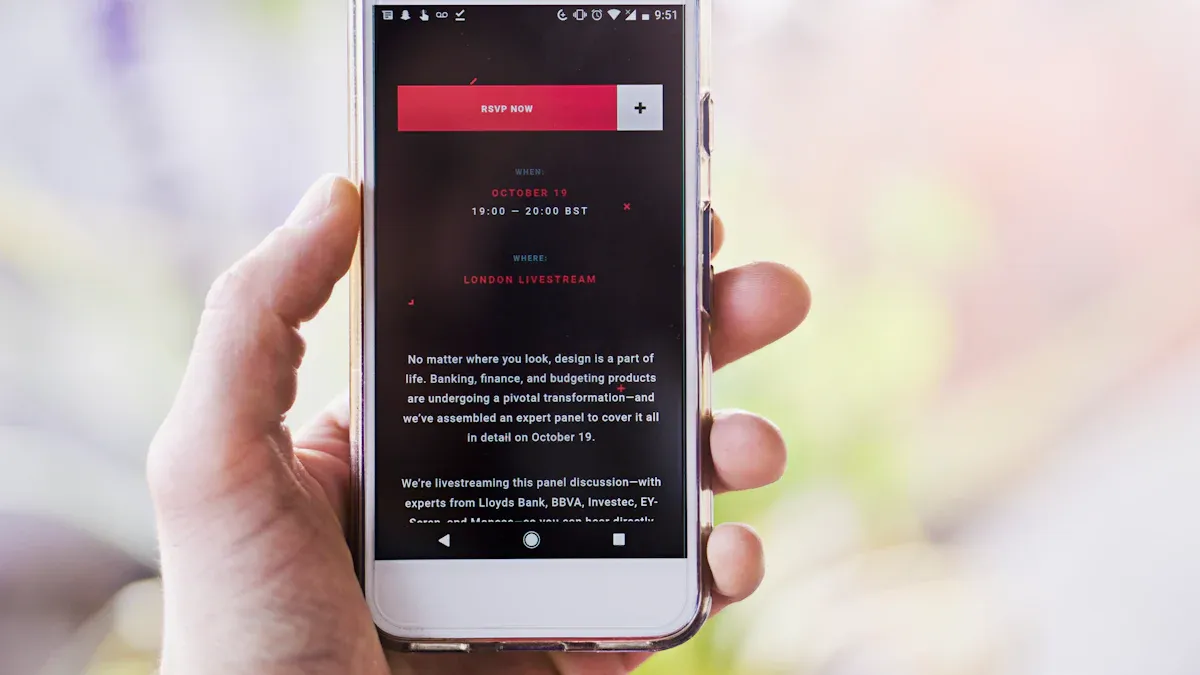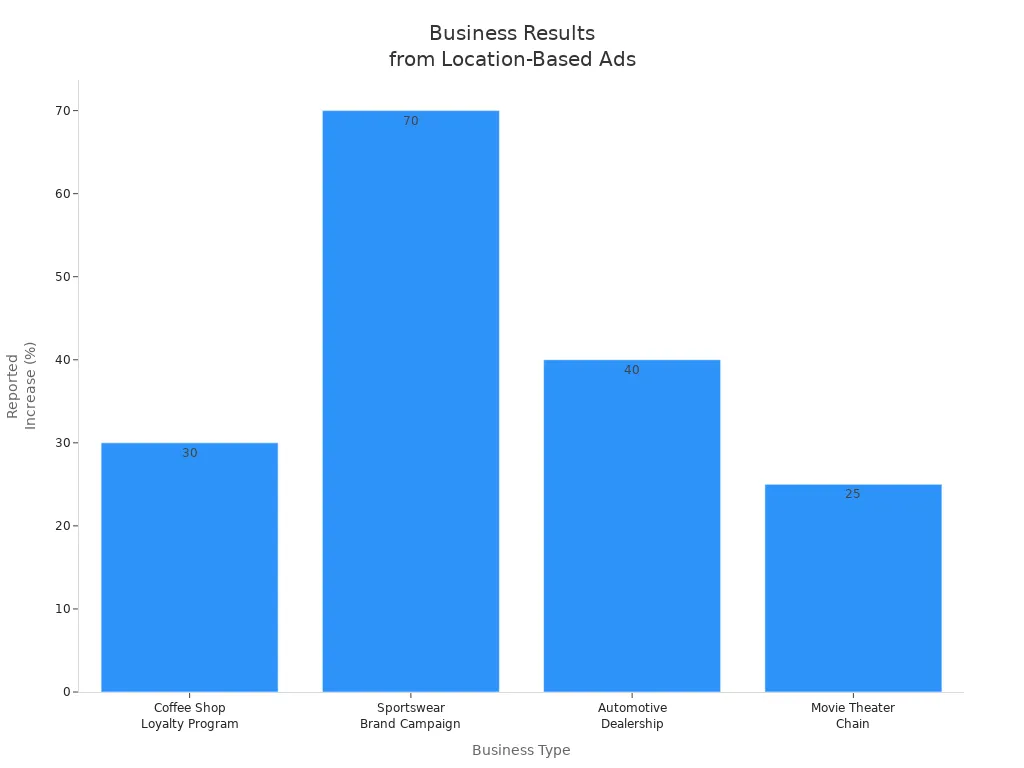
Location-based ad triggers change how you react to ads. New campaigns show these triggers can boost conversion rates by 40%. Brands like McDonald’s saw 20% more people visit their stores. Many companies use geo-targeting and beacon technology now. They send you offers that fit where you are and what you want.
Location-based ad triggers help businesses avoid showing ads to people who will not care. They reach you when you are most likely to act.
Key Takeaways
Location-based ad triggers give you special offers where you are. This makes ads feel more useful and important to you.
These ads get your attention and make you act fast. You may visit stores more and like the brand more.
Tools like geofencing, beacons, and real-time targeting help businesses find you. They send you deals at the best time and place.
Businesses can see results fast. They notice more sales, more visits, and better ad spending with location-based ads.
When businesses respect privacy and let you choose to share your location, you trust them more. This also makes the ads work better.
Location-based ad triggers and consumer behavior
Personalization and relevance
People like ads that are about things they care about. Location-based ad triggers let companies send messages that match what you need and where you are. If you walk by a store, you might get a special deal on your phone. This makes the ad feel just for you and helpful. A study in 2021 showed people enjoy these ads if they are not annoying and fit their location. In fact, 71% of people want businesses to give them ads made for them. If you do not get this, you might feel upset.
Personalized ads can help you trust a brand more. When you see offers that match your likes and where you are, you may feel closer to the brand. You might even think the brand is more honest. But if an ad feels too personal or like it is spying on you, you might not like it. You could feel your privacy is not safe or your choices are taken away. Companies must make sure they respect your privacy while making ads personal.
Here are some ways these ads can affect how you feel:
You might feel upset if you think the ad takes away your choices.
Ads that bother you can make you feel annoyed.
Personalized ads can make you feel special and important.
You trust the ad more if it helps you and is not pushy.
Feelings like curiosity or surprise can make you want to learn more or do something.
Marketers use your real-time location to send messages at the best time. For example, you might get a coupon while you are on your way to work or near another store. This makes the ad matter more and makes you more likely to respond.
Engagement and response
Location-based ad triggers do more than just show you ads. They get you to do something. If you get a message about a sale or event close by, you might go to the store or try something new. These triggers use your location to send deals that feel important and urgent.
Let’s see how these ads change your choices:
Effect on Consumer Decision-Making | Explanation |
|---|---|
Increased Engagement | Ads fit where you are, so you notice them more. |
Improved Customer Loyalty | Real-time deals and special offers make you want to return. |
Higher Foot Traffic | Alerts about deals nearby bring you into stores. |
Better Customer Insights | What you do helps businesses know what you like. |
More Informed Decision-Making | Quick info helps you choose faster and feel good. |
Location-based ad triggers can double or triple how much people pay attention compared to normal ads. For example, geo-aware ads can get a click rate of 1.0%, but regular ads only get 0.4%. Some ads, like H&M’s geo-fenced ads, have reached 2.3%.
These ads also make people act right away. When you walk into a geofenced area, your phone might buzz with a deal that ends soon. This makes you feel like you need to hurry. You might feel you have to act fast, especially if the message says there are not many deals left or it ends soon. This rush, plus seeing others take the deal, makes you decide quickly.
You react best when ads are on time, matter to you, and respect your privacy. If you feel the ad helps you or gives you something special, you are more likely to pay attention and maybe become a loyal customer.
Types of location-based ad triggers

Location-based ad triggers use different tools to reach you. They work at the right place and time. Each type helps businesses connect with you. They also help boost how much you pay attention.
Geofencing
Geofencing makes a pretend border around a real place. This could be a store or an event. When you walk into this area, your phone can get a special alert. You might get a deal or a coupon. GPS helps know when you are close. Many companies use geofencing to bring you into stores. They send deals when you are nearby.
For example, Starbucks sends a coupon if you walk near their shop. Dunkin’ gives a free donut offer if you are close to their store. These alerts make you want to visit and buy something.
Here is a table that shows how geofencing and geo-targeting are different:
Feature/Aspect | Geo-Targeting | Geo-Fencing |
|---|---|---|
Precision | Covers big areas, good for reaching many people | Very exact, sends ads when you enter a set zone |
Use Cases | Online ads, retargeting, interest-based campaigns | Instant action, brings more people into stores |
Engagement Trigger | Based on location and interest | Based on entering or leaving a certain area |
Technology Used | IP address, GPS | GPS, WiFi, Bluetooth |
Ideal For | Big campaigns | Local, quick action |
Lots of businesses use geofencing. Stores, restaurants, banks, and car dealers use it. You get alerts about sales or events when you are close by.
Beacons and proximity
Beacons are small gadgets put inside stores or places. They use Bluetooth to send messages to your phone. This happens when you are very close, just a few feet away. This is called proximity marketing. You might get a coupon or info about a product. Sometimes you get a reward for trying on clothes.
Target helps you find things in the store with beacon alerts.
Kroger sends digital coupons when you walk by certain aisles.
A study found 60% of shoppers use beacon messages. About 30% use the offers right away. Beacons help stores learn what you like. They make shopping easier and more fun.
Real-time targeting
Real-time targeting sends you ads based on where you are. It also looks at what you are doing right now. This uses data from your phone, GPS, and sometimes the weather. You might get a lunch deal if you are near a restaurant at noon. You could get a sale alert when you walk into a mall.
Real-time targeting helps businesses reach you at the best time.
You see ads that fit your needs and where you are, so you notice them more.
This way makes you pay more attention and act fast.
Location-based ad triggers like these help companies send the right message. They do it at the right time. This makes ads more helpful and less annoying.
Conversion rates and business impact

Measurable results
Location-based ad triggers help you see real results. When you use these tools, you can track how many people visit your store, click your ads, or buy your products. You do not have to guess if your ads work. You can see the numbers.
A case study by Digital Media Solutions showed that a brand using custom geo-targeting saw a 76% jump in conversion rates. The company also spent 17-25% less on ads. This means you can get more customers and save money at the same time. Other reports show that location-based ads can boost conversion rates by up to 20%. You reach people who are close to your store and ready to buy.
You can measure your success in many ways:
Foot traffic and store visits: You see more people coming into your store after they get your ad.
Conversion rates: You track how many people buy something or sign up after seeing your ad.
Cost per visit or cost per sale: You check how much you spend to get each new customer.
Click-through rates: You see how many people tap on your ad.
Reach and impressions: You know how many people in your target area see your message.
Location-based ad triggers let you focus your budget on the best areas. You do not waste money on people who are far away or not interested.
Here is a table that shows how different businesses improved after using location-based ads:
Business Type | Measurable Result | Metric Type |
|---|---|---|
Coffee Shop Loyalty Program | 30% increase in loyalty point redemptions | Redemption rate increase |
Sportswear Brand Campaign | 70% engagement rate during event-driven ads | Engagement rate |
Automotive Dealership | 40% increase in test drive bookings | Booking increase |
Movie Theater Chain | 25% rise in same-day ticket sales | Sales increase |
General Businesses | Improved CTR, conversion rates, and ROAS | Various marketing KPIs |

You can also use dynamic pricing and timely offers to drive more sales. For example, AutoZone shows you if a product is in stock at your nearest store. You see “1 in stock,” which makes you want to buy before it runs out. This creates a sense of urgency. You get store hours and contact info, so you can act fast. These steps make it easy for you to decide and buy right away.
Many companies use real-time offers to boost sales. Starbucks sends you a coupon when you walk near a store. Domino’s sends you a pizza deal during a local sports game. These timely messages make you want to act now. You get the right offer at the right time, which helps you make quick choices.
Dynamic pricing also helps. Airlines raise ticket prices during holidays. Rideshare apps like Uber use surge pricing when demand is high. Amazon changes prices based on demand and time. These tactics match what you are willing to pay and help companies sell more.
Repeat visits and loyalty
Location-based ad triggers do more than just boost one-time sales. They help you build loyalty and keep customers coming back. When you get a special offer while near a store, you feel valued. You remember the brand and want to return.
Loyalty programs work better with location-based ads. For example, a coffee shop saw a 30% jump in loyalty point redemptions after sending location-based offers. You get reminders to use your points or try a new drink when you are close by. This makes you more likely to visit again.
You also see higher engagement during special events. A sportswear brand reached a 70% engagement rate by sending event-driven ads. You feel connected to the brand when you get offers that match what is happening around you.
When you receive timely, personal offers, you feel special. You trust the brand more and want to come back.
Businesses use these tools to learn what you like. They send you better offers each time. You get rewards for repeat visits, which makes you loyal. Over time, you become a regular customer.
You can see the impact in many ways:
More repeat visits to stores
Higher loyalty program use
Better customer feedback
More word-of-mouth referrals
Location-based ad triggers help you turn first-time buyers into loyal fans. You get offers that matter to you, at the right place and time. This keeps you coming back and helps businesses grow.
Implementing location-based ad strategies
Best practices
You can make your campaigns more effective by following a few key steps. Start by personalizing your ads. Most people expect messages that match their interests and location. If you do not personalize, you risk losing their attention. Use geofencing to set up virtual boundaries around places like malls or stadiums. When someone enters these areas, send them a special offer. Try geoconquesting to reach people near your competitors with better deals. Adjust your ads based on the weather or time of day. For example, show umbrella ads when it rains or promote breakfast deals in the morning.
Tip: Always give users the choice to opt in or out of sharing their location. Respecting privacy builds trust and keeps your audience happy.
Here are some best practices:
Send real-time notifications to people near your store.
Use location data to create offers that feel personal.
Coordinate your ads across different channels for a smooth experience.
Technology and privacy
You need the right tools to run successful location-based ad triggers. GPS, Wi-Fi, and Bluetooth beacons help you find where your customers are. Use geofencing to send ads when people enter certain areas. Combine this with customer data to make your ads even more relevant.
Privacy is very important. Always get clear permission before collecting location data. Follow rules like GDPR and CCPA, which require you to let users know what data you collect and why. Only keep the data you need, and store it safely. Let users see or delete their data if they ask. Mobile phones now let people control how they share their location, so make sure your app or website supports these settings.
Campaign optimization
To get the best results, track your campaign performance closely. Watch key numbers like foot traffic, conversion rates, and click-through rates. Use this data to see what works and what does not. Change your ads based on real-time feedback. Create content that matches local events or trends. Run your ads on different platforms, such as social media and search engines, to reach more people.
You can use a table to track your main metrics:
Metric | What It Shows |
|---|---|
Foot Traffic | How many people visit stores |
Conversion Rate | How many take action |
Click-Through | How many click your ads |
ROI | How much you earn vs. spend |
Keep testing and improving your campaigns. This helps you reach the right people and get the most value from your ads.
Location-based ad triggers let you talk to customers at the best time. You can make people happy by sending special offers just for them. You can also give tips that help right away. These tools help people pay more attention and visit your store more often. They also help you sell more things. Using data helps you find the right people and change your ads to work better. Watch important numbers and use what you learn about your area. This will help your ads work better. Try these ideas to make people come back and help your business grow.
FAQ
What is a location-based ad trigger?
A location-based ad trigger sends you ads or offers when you enter a specific area. Your phone uses GPS, Wi-Fi, or Bluetooth to know your location. You get messages that match where you are.
How do location-based ads protect my privacy?
You control your location settings. Most apps ask for your permission before using your data. Good companies follow privacy laws and let you opt out at any time.
Do location-based ads really increase sales?
Yes! Many businesses see higher sales and more store visits. For example, some stores report up to 40% more conversions after using these ads. You get offers when you are ready to buy.
Can I stop getting location-based ads?
You can turn off location sharing in your device settings. Most apps let you change your ad preferences. If you do not want these ads, you can opt out easily.
See Also
How G37 Apple CarPlay Adapters Revolutionize Your Driving
Key Developments Influencing Wireless Android Auto Adapters Today
Best Wireless Android Auto Adapters Reviewed For 2025
Budget-Friendly Portable CarPlay Solutions Suitable For All Drivers
Understanding Wireless CarPlay Adapters And Enhancing Your Commute
